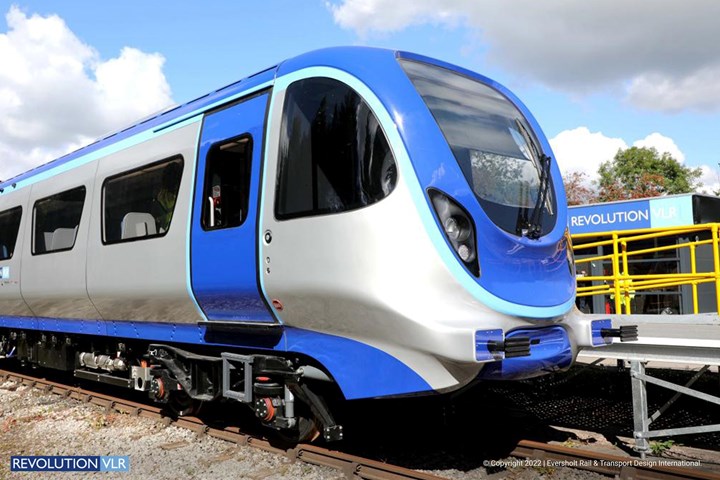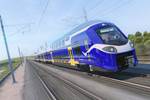TRB Lightweight Structures contributes composite bodyshell design to passenger train demonstrator
The Revolution VLR (Very Light Rail) passenger vehicle serves to simplify existing rail networks and reopen historical lines, while adhering to rigorous rail and sustainability regulations.

Revolution VLR vehicle. Photo Credit: Revolution VLR
TRB Lightweight Structures (TRB, Huntingdon, U.K.) announces it has joined the team behind the Revolution VLR (Very Light Rail), a passenger vehicle designed to simplify extension of existing rail networks and allow the reopening of historical lines. TRB has worked closely with consortium leader Transport Design International (TDI) (Stratford-upon-Avon, U.K.) on the demonstrator vehicle’s composite bodyshell design, manufacturing the modular, one-piece structural panels that form both the inner and outer walls.
The design objectives for the Revolution VLR were to engineer a substantially lighter vehicle offering reduced energy consumption, while adhering to rigorous rail industry safety standards and governmental decarbonization goals. To achieve these aims, TRB developed modular panels composed of molded carbon fiber laminates with a recycled foam core. TRB notes that its expertise in the tooling and materials processing ensured a high-quality, lightweight solution that met the design brief without compromising structural strength.
The project also took advantage of a polyfurfuryl alcohol (PFA) bioresin — a sustainable alternative to phenolic resins derived from a byproduct of sugar cane refining. Combined with a host of other innovative technologies, this resulted in a modular construction 40% lighter than traditional heavy rail vehicles of similar capacity. This means that the single-carriage vehicle can run on reinstated existing lines, or new routes using lighter weight track infrastructure.
“Our lightweight structural modular panels not only contributed substantially to a 16-tonne reduction in total weight, but were also obtained from a sustainable source,” Lyndon Newman, lead engineer at TRB Lightweight Structures notes. “This will significantly contribute to government commitments to decarbonization in transport.”
“The team at TRB worked hard to meet all the technical requirements of the project, producing lightweight, modular body panels that adhered to strict tolerances for the Revolution VLR Demonstrator,” adds Paul Salkeld, design director at Transport Design International. “This not only allows construction of a lighter vehicle, but also assists in the replacement of parts for general maintenance requirements, which is a key consideration for vehicle longevity, given a 30- to 40-year lifespan.”
The Revolution VLR Consortium’s other members include RSSB, Eversholt Rail, WMG at the University of Warwick, Cummins, RDM Group and Transcal.
Related Content
-
Daher inaugurates Learning Center for training aeronautical talent
Daher offers a concrete solution to the shortage of qualified professionals in aerospace, providing a range of technical programs that prepare workers for the sector’s rigorous demands.
-
New online training course targets prepreg basics
JEC World 2024: Composites Expert highlights how its E-Learning Composites Academy platform supports flexible industry learning with new courses developed with Stelia Aerospace North America.
-
Winona State, IACMI invest in composites workforce development
First composites hub in the IACMI-managed ACE national training program funds free bootcamps to equip students and community with hands-on composites skills, knowledge.
















